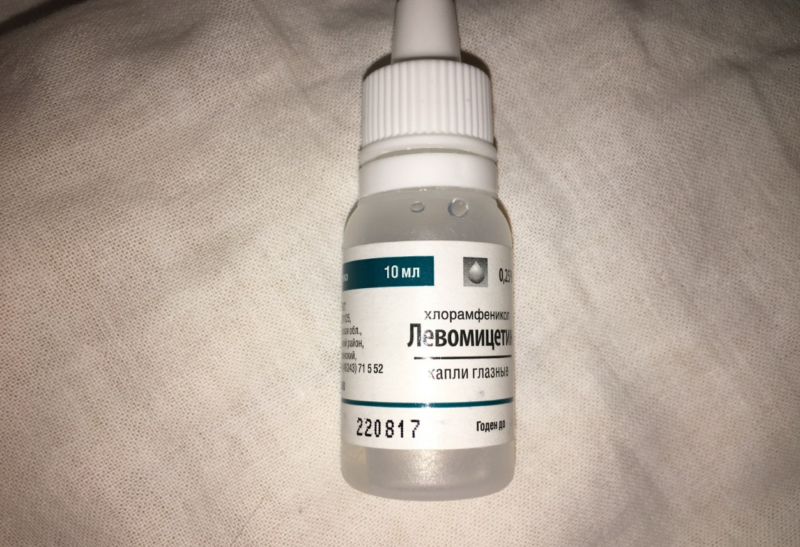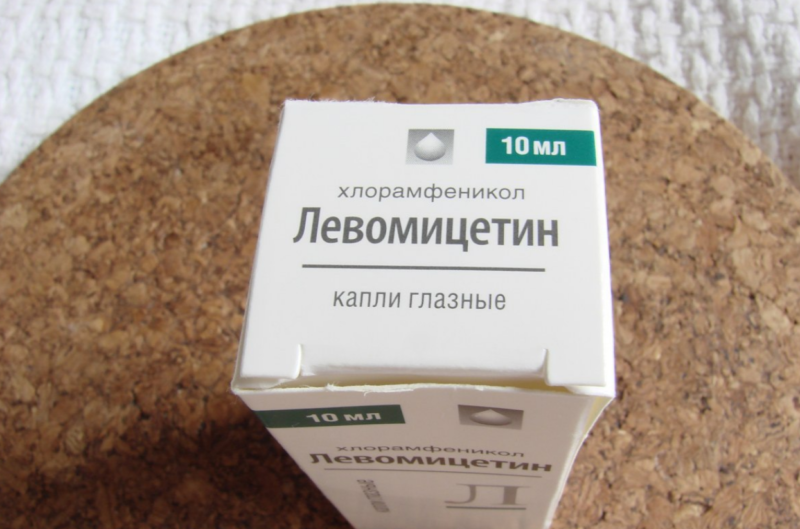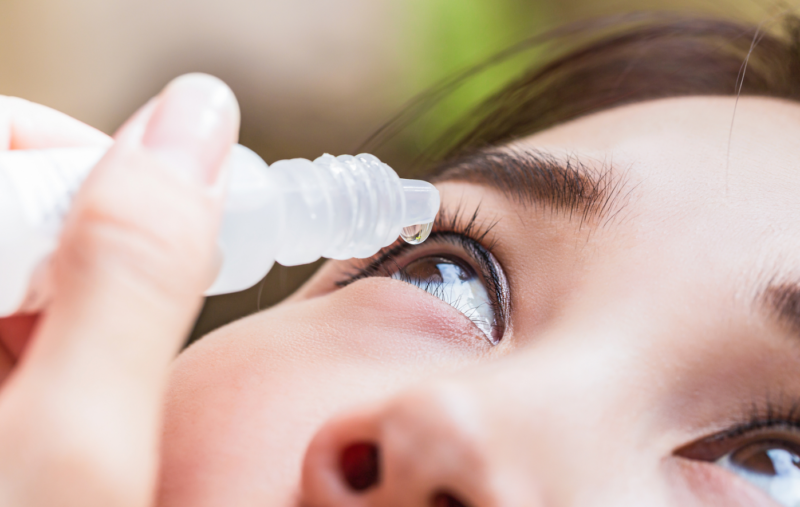Eye drops for children Levomycetin is a highly active antimicrobial medication that belongs to topical antibacterial agents. It is used in ophthalmology in babies from 2 years old, and in severe processes and with the permission of a doctor, at an earlier age. Drops are effective in diseases of the eyes caused by bacteria of various types, and do not have synonyms - ophthalmic agents with the same active substance.
Material Content:
The composition of the drug
Ophthalmic medicine Levomycetin 0.25% is made in the form of transparent drops, poured into hermetically sealed dropper bottles from polymer plastic with a volume of 5 or 10 ml.
The treating basis of the medication is the antibiotic substance chloramphenicol. 1 ml of drops contains 25 mg of this element.
An additional active component is boric acid, which has an antiseptic and antipruritic effect, preventing the secondary development of a bacterial infection.
Sterilized water in solution is an inactive component of the product.
What is prescribed eye drops of chloramphenicol
The therapeutic properties of the drug are determined by the activity of chloramphenicol, which stops the process of reproduction and growth of colonies of pathogens by inhibiting the production of important proteins necessary for their vital activity and development.
Chloramphenicol affects various types of microbes, including those that cause inflammatory eye diseases, including:
- meningococcus, hemophilic bacillus, pneumococcus;
- staphylococcal and streptococcal microflora;
- Escherichia coli, Klebsiella;
- causative agents of diphtheria, anthrax, brucellosis, pertussis of the plague.
Salmonella, enterobacteria, shigella, Pseudomonas aeruginosa, clostridia and protozoa are insensitive to the action of chloramphenicol.
Conjunctivitis eye drops are used topically for the following ophthalmic pathologies:
- conjunctivitis or inflammation of the mucous membrane of the eye (soreness, sand sensation, redness, purulent discharge, eyelid clumping, itching);
- blepharitis - inflammation of the edges of the eyelids (including species such as scaly, ulcerative, meibomian);
- keratitis, keratoconjunctivitis or inflammation of the cornea (clouding, ulceration, soreness and redness of the eye) with subsequent dangerous eye complications and visual disturbances.
Chloramphenicol resists the aggression of many bacteria that cause infections in children, including those against which other antimicrobials are ineffective - Penicillin, Sulfanilamides, Streptomycin.
After instillation, most of the healing substance is actively absorbed into the eye tissue and a minimal amount into the circulatory system, which does not harm the child’s body when used correctly. A high content of chloramphenicol is determined in the intraocular fluid, iris, cornea, vitreous body, however, the therapeutic substance does not penetrate into the lens.
Instructions for use and dosage for children
In the annotations of different manufacturers, the age is not the same from which the use of drops is allowed.
Standard conditions of use
Summarizing information from medical sources, we can summarize:
- In all cases, it is permissible to treat drops from 2 years old with drops. The standard scheme provides for 3-4 times the use of Levomycetin in 1 drop, and it is advisable to discuss the frequency of use of the drug with a pediatrician before starting therapy.
- The ophthalmologist will determine the frequency and dose, based on the type and characteristics of the disease, the age of the child and the severity of the clinical picture. So, with complicated inflammation with purulent discharge, the doctor may recommend a more frequent instillation.
- If parents began to treat the child on their own, it is highly undesirable to use drops longer than 3 days. Only a specialist will decide whether the greediest use of the solution is necessary.
It should be borne in mind that the maximum course of therapy is limited to 2 weeks, otherwise allergic reactions, severe side effects and development of resistance to chloramphenicol in bacteria are possible.
Breastfeeding
Eye drops of chloramphenicol for children up to a year are prescribed for severely occurring pathologies from 4 months of life - exclusively in individual cases, and if there are no other, safer medications for ophthalmic.
Special care is required when treating infants with medication. Chloramphenicol adversely affects the bone marrow, inhibits the production of proteins. With long-term use, the baby may have allergies, nausea, vomiting, loose stools, and hemoglobin may decrease.
Infants under 4 months of age are not allowed to use chloramphenicol drops., since their organs are still underdeveloped and very weak. The active component that enters the body can accumulate in the tissues and blood, causing a toxic effect (in fact - poisoning). In this case, the appearance of signs of a “gray syndrome” dangerous for babies is likely, leading to disruption of the respiratory system, kidneys, blood vessels, and heart.
Basic symptoms: respiratory distress, oxygen deficiency, leading to a bluish-gray skin color, temperature drop, weakening of all normal physiological reactions.
But from 2 years, children usually tolerate therapy with Levomycetin drops very well (in the absence of contraindications), especially with a short course and quickly recover.
Eye drops in nose
Since the medication is an antibiotic that kills bacteria not only in the eyes, but also in the nasal cavity, eye drops of chloramphenicol in the nose can be used for a child older than 2 years with purulent rhinitis, when the baby has greenish-yellow discharge from the sinuses, as well as rhinopharyngitis and sinusitis caused by a bacterial infection. Dosage - no more than 1 drop in each nasal passage 3 times a day and only with the permission of the pediatrician. It should be borne in mind that when instilled into the nose, the substance easily enters the baby’s stomach, sliding along the wall of the pharynx, and chloramphenicol is absorbed into the blood. This can lead to unwanted adverse reactions in the child. In order for such a patient to swallow less solution, you need to turn the baby’s head in the direction of the nostril where the medicine is injected, and not to throw his head back.
Due to the rather high toxicity of the drops, it is not recommended to use them in childhood without the need or with the usual manifestations of eye irritation in the presence of acute respiratory infections, acute respiratory viral infections, influenza, catarrhal cold.
Drug interaction
With the parallel use of chloramphenicol:
- with penicillins, their bactericidal action is weakened;
- with anticoagulants of indirect influence (Warfarin), drugs with phenobarbital, phenytoin - an increase in the blood levels of these pharmaceuticals, an increase in action and side effects;
- with medications, including clindamycin, erythromycin, lincomycin, a mutual decrease in the therapeutic result is observed.
For example, if Levomycetin drops are used together with an erythromycin ophthalmic ointment, the expected effect of both agents is weakened.
To prevent the negative effect of chloramphenicol on hematopoiesis, it is undesirable to instill the medicine in the nose while using nasal medications containing sulfonamides, for example, Ingalipt aerosol.
Contraindications, side effects and overdose
Levomycetin drops are not allowed in the following cases:
- intolerance to any components of the substance, as well as drugs with chloramphenicol, thiamphenicol, azidamphenicol;
- psoriasis, eczema, fungal infection;
- babies under 4 months old;
- blood diseases associated with inhibition of blood formation;
- serious liver disease;
- lack of glucose-6-phosphate dehydrogenase in the body.
Women awaiting delivery and nursing mothers are prescribed drops with caution, a short course and only for instillation into the eyes. In this case, the treating substance enters the blood in such minimal quantities that it is not able to have a negative effect on the body of the embryo or baby.
Caution is required if the patient undergoes chemoradiotherapy, takes sulfonamides, cytostatics (inhibiting hematopoietic function).
The most common adverse reaction in children is burning, eye irritation, itching, redness, and lacrimation. Sometimes - temporary blurred vision.
In young children up to 1-2 years of age, an overdose of the drug can lead to the following manifestations:
- nausea, vomiting, diarrhea;
- “Gray syndrome”, in the acute development of which, without active treatment, 40 out of 100 babies die.
With uncontrolled prolonged use of Levomycetin drops, fungal damage to the mucous membrane of the eyes and eyelids sometimes develops. If increased doses are instilled for a long time (more than 2–4 grams per day), anemia may develop, a marked decrease in the level of leukocytes and platelets.
For all acute or dangerous manifestations, the drug is immediately canceled.
Analogs of Levomycetin in drops for a child
Analogues of chloramphenicol drops in pediatrics - medicines with other antibiotic treating substances and a similar effect:
drops of Azidrop, Signicef and Ciprofloxacil, Cipromed, Maxiflox (from 1 year), Sulfacil sodium.Erythromycin eye ointment can also be used from a newborn age.
Such antibacterial agents as Phloxal (Ofloxacin), Gentamicin, Tobrex, Okomistin in children and adolescents are used only with the permission of the children's optometrist, and most often over the age of 14 years.

















